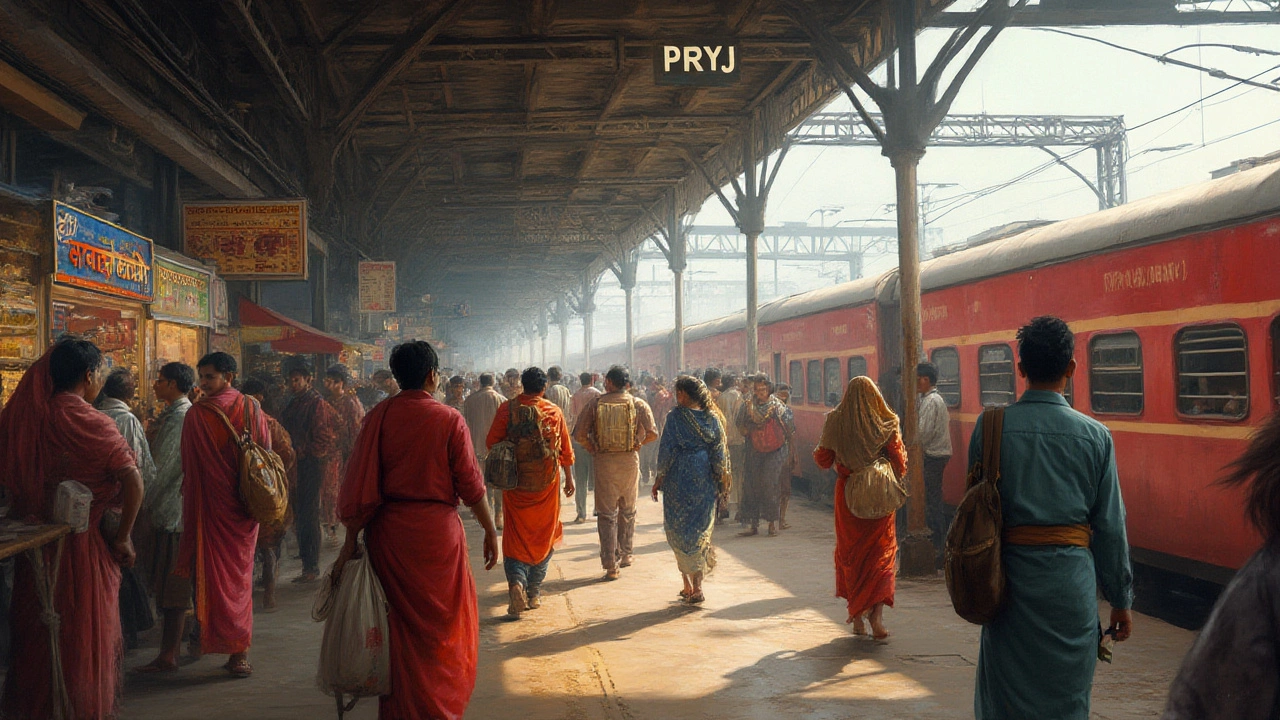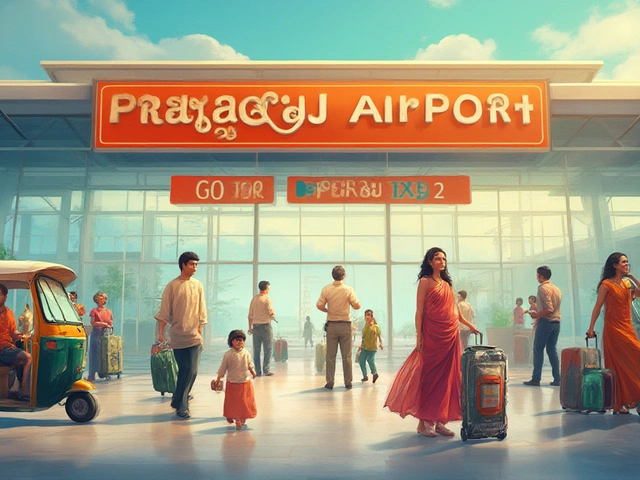Prayagraj 3 Letter Code: Your Guide to Airports, Railways, and Travel
Ever stopped to wonder what those three little letters on your plane ticket or train reservation mean? You know, the cryptic codes that somehow speak the international language of travel. Well, if you've set your sights on the historic city of Prayagraj—maybe for the iconic Kumbh Mela, a Ganga snan, a business trip, or just to see where the Ganges, Yamuna, and Saraswati famously meet—knowing the right three-letter code could save you from a serious travel headache. Lost bags, wrong train tickets, missed airport transfers? Yikes. But here's what's wild: Prayagraj actually has more than one code floating out there, depending on where and how you're traveling. Let’s get into it.
Prayagraj Airport Code: The IATA Three-Letter Identifier
Alright, so when you book a flight anywhere on the planet, you deal with IATA codes. That’s the three-letter shorthand that airlines, airports, and booking sites all use. For Prayagraj, the airport code is IXD. It stands for Allahabad Airport (yes, some places still use the old name), which officially switched to Prayagraj Airport but kept its original IATA code. If you pull up your airline booking, check your baggage tag at the airport, or scan a flight status board, 'IXD' is what you’re looking for.
Some quick facts to file away:
- IXD punches way above its weight for a regional airport, with daily flights to big cities like Delhi, Mumbai, Bengaluru, and Kolkata.
- The code hasn’t changed since the name update, because IATA codes rarely get revised—airlines and booking systems prefer to keep the old codes for consistency.
- Airports Council International and global security systems are all tuned into IXD, so using Prayagraj’s other names won’t cut it if you’re searching for flights.
If you’re booking a flight from Kolkata to Prayagraj, check that your e-ticket says “Kolkata (CCU) – Prayagraj (IXD)” before you hit that checkout button. Lots of folks still confuse this, especially since the city got rebranded from Allahabad to Prayagraj just a few years ago. Pro tip: When giving your itinerary to someone unfamiliar, mention “IXD, the old Allahabad Airport”—you’ll avoid a lot of blank stares!
| City | IATA Airport Code | Airport Name |
|---|---|---|
| Prayagraj | IXD | Prayagraj Airport (Allahabad) |
| Delhi | DEL | Indira Gandhi International |
| Mumbai | BOM | Chhatrapati Shivaji Maharaj International |
Why does all this matter? Mixing up the code could send your checked bag, or even your travel plans, somewhere totally different—nobody wants their suitcase ending up in Indore (IDR) when they’re headed for the confluence of the Sangam!
Prayagraj Junction Railway Station: The Indian Railways Code
Maybe you’re more of a train person—after all, few things feel as Indian as hopping on a long-distance express and watching the countryside slide by. Here’s where it gets interesting: Prayagraj Junction has its own three-letter railway code—'PRYJ.' But if you’re old-school or browsing rail sites that haven’t updated since the city’s name change, you might bump into the older code 'ALD,' which stands for Allahabad. Indian Railways officially switched to 'PRYJ' in February 2020, after the city’s renaming (for both station signage and reservation systems). Squint at your next train ticket, and you’ll spot it.
Some interesting quirks and notes for train travelers:
- 'PRYJ' is now the official station code for all mail, express, and superfast trains that stop at Prayagraj Junction.
- Smaller Prayagraj stations, like Prayagraj Chheoki (PCOI) and Prayag (PRG), each have their own unique three or four-letter codes as well.
- If a travel agent enters 'ALD' instead of 'PRYJ,' the booking will redirect you to Prayagraj Junction, but Indian Railways now standardizes 'PRYJ' for most official paperwork and tickets.
Why care about the station code at all? Try searching 'Allahabad' on ticketing apps—you’ll often get a warning or a note about using the correct code. Entering the wrong thing could mean you accidentally book for a different station (like Allahabad City, code 'ALY'), which is definitely not where most express trains go.
For anyone changing trains, double-check your ticket to make sure both the name and station code match up. Especially during crowded festival seasons—when the Kumbh Mela attracts millions—knowing the right code is the difference between a smooth transfer and a massive headache.

Historical Context: From Allahabad to Prayagraj and the World of Codes
Here’s a fact that’ll get you a nod from history buffs: Prayagraj wasn’t always called Prayagraj. Up until 2018, it was “Allahabad”—and let’s be honest, a lot of folks (including airlines, postal services, and booking agents) use the names almost interchangeably. The city was renamed Prayagraj to celebrate its religious and historical roots. But updating all the codes and records? That doesn’t happen overnight.
This is why the airport still goes by IXD instead of, say, PRY. IATA codes don’t always match city names—London Heathrow is LHR, Mumbai is BOM (for Bombay), Chennai is MAA (from Madras), and so on. Airports hang onto their legacy codes, so the tech works behind the scenes.
- Prayagraj’s major railway code moved from ALD (Allahabad) to PRYJ, but a patchwork of sites and databases still carries both names and codes. Always double-check when booking!
- The switch from ALD to PRYJ made big waves in the Indian Railways system. The railway station was repainted, tickets changed, and even the station jingle got a revamp.
- The airport code IXD still shows up as Allahabad in a lot of foreign booking sites. This isn’t a glitch—it’s just how the aviation industry works for consistency’s sake.
If you’re curious, here’s how these codes get made: IATA assigns airport codes, almost always three letters. Indian Railways uses three or four-letter station abbreviations, adjusting as cities change names. It’s not always logical—sometimes it’s about what’s available, sometimes there’s a history behind it, and occasionally, it helps with pronunciation or recognition for folks working in the industry.
During the city’s renaming, there were piles of paperwork, public signage to change, and old codes to update in computer systems. While the signs on the street say Prayagraj, the aviation and railway sectors have different speeds for shifting over to the new names. This can throw people off, so when in doubt, check the codes, especially if you’re booking long-haul connections or transferring between airlines or railways.
Tips for Travelers: Making Sense of Prayagraj’s Codes
Knowing codes isn’t just for airline agents or travel pros. For everyday travelers, a little code knowledge means saving time, avoiding mistakes, and, yes, even impressing the person at the ticket counter. Here’s how you can put this to use:
- Flight bookings: Always search for flights to IXD if you’re headed to Prayagraj, even if the airline says Allahabad. If you can’t find “Prayagraj” on some international booking sites, look up 'Allahabad.' Rest assured, it’ll land you at the right spot.
- Train journeys: On IRCTC or any ticket portal, use ‘PRYJ’ as your code for the central Prayagraj station. If you come across ‘ALD,’ that’s fine too, but expect a gradual phase-out.
- Luggage tags and boarding: Double-check your bag tags and boarding passes. Bags labeled IXD will go to Prayagraj airport, not some other ‘P’ city in India.
- Navigation apps: Entering IXD or PRYJ on Google Maps, cab booking apps, or ride-sharing services drops you right at the right terminal or platform.
- Festival seasons: During the Kumbh Mela or Magh Mela, book tickets well in advance and cross-check the codes—temporary platforms and extra trains often get added, and codes really help keep things straight.
One last fun tidbit: If you like collecting boarding passes or train tickets as souvenirs, see if you spot both the old and new codes—sometimes, station boards and digital tickets will use both for a while. It’s a quirky reminder of how cities evolve but don’t always leave their past behind in a hurry.
| Type | Three-letter Code | Notes |
|---|---|---|
| Airport (IATA) | IXD | Still listed as Allahabad in many systems |
| Railway Station | PRYJ | Officially 'Prayagraj Junction,' formerly 'ALD' |
| Railway (Old) | ALD | Legacy code; phased out |
So next time you’re booking that trip, remember: there’s a story behind every three-letter code. Whether you’re catching a train or a flight, decoding Prayagraj’s 3-letter code makes you the savvy traveler who always ends up in the right place—no matter what the ticket says!






11 Comments
Henry Kelley
July 17 2025Hey, this guide really cleared up the confusion I had about those codes! I always wondered what the 3-letter abbreviations stood for when booking trips through Prayagraj. It’s interesting how the airport and railway have distinct codes, yet both play such a crucial role in travel there.
Speedy references like these really help when you're coordinating your itinerary, especially if you’re hopping between trains and flights. The tips section was pretty neat, too — I didn’t know some stations share similar codes across different cities, which can be quite misleading.
Anyone else find these codes surprisingly useful beyond just ticketing? Like, I sometimes use the airport code shorthand for quick communication in my travel group chats. Just shows how little things can simplify travel planning.
Santhosh Santhosh
July 19 2025As someone living in India, I appreciate how these 3-letter codes can sometimes reflect historic or local significance beyond just transportation convenience. Prayagraj’s code doesn’t just string letters together randomly; there’s a story embedded in these abbreviations that tie back to the region’s identity.
This post prompted me to think about how regional railways and airports foster connections not just geographically, but culturally and socially as well. It’s fascinating how a simple code can bridge global travel with local heritage.
However, a more detailed explanation of each code’s origin might be helpful for travelers like me who enjoy the context behind these travel symbols. Overall, this guide is an excellent starting point!
Victoria Kingsbury
July 20 2025Wow, it's actually quite a jargon-rich environment with all those codes flying around! The post does a fair job at unpacking it, but I’m curious—does anyone else find the constant barrage of airport and railway acronyms a bit overwhelming? I mean, it’s essential info, but sometimes it reads like a secret code only insiders can crack.
I think a visual map or a quick cross-reference table might make it even more user-friendly. That aside, tips about avoiding confusion with similarly coded stations are gold in a place like India, which has such an extensive network.
Anyone experienced accidentally booking the wrong station because of these codes? Would love to hear stories!
Ray Htoo
July 21 2025This guide really got my gears turning about the creativity behind these abbreviations. It’s kinda like an art form matching succinct codes to place names, balancing memorability and uniqueness. Plus, knowing the codes beforehand can save you from some nasty last-minute scrambles at the airport or station.
The mention of Prayagraj's airport code and railway code side by side was especially helpful. I've always mixed those two up since I travel by both modes frequently.
Anyone here use apps that automatically detect these codes and help with travel plans? If so, which ones are reliable and user-friendly?
Tonya Trottman
July 22 2025Ah yes, the ever-enigmatic 3-letter codes—because clearly, a whole city name wouldn’t suffice in the modern world of super efficiency and minimalism. Nothing like compressing your destination to a cryptic abbreviation to make travel more 'thrilling,' right?
But seriously, for those of us who care about linguistic clarity, these codes can be an absolute nightmare. Like, why not just call it what it is and save us from deciphering airport hieroglyphs? Anyway, this post was surprisingly straightforward for this topic, so kudos there.
Also, if anyone screamed internally upon seeing similar codes for vastly different places, you’re not alone. Travel brains, unite!
Veera Mavalwala
July 23 2025Living in India, I find it imperative that travelers grasp the subtle yet powerful nuances embedded within these three-letter designations. They serve not only as logistical markers but as vibrant waypoints narrating the tales of diverse locales. Consider how Prayagraj’s stations embody more than transit points; they reflect centuries of cultural amalgamation.
The article’s tips rightly underscore the necessity of discerning these codes accurately to navigate the labyrinthine Indian travel network. I do wish there was a deeper dive into the etymology and historical resonance of these codes, which would elevate the traveler’s experience multifold.
Such an illuminating guide calls for a sequel focusing on how these codes interface with India’s rich tapestry of languages and histories.
Rocky Wyatt
July 24 2025This primer on Prayagraj’s codes kind of leaves me conflicted. On one hand, it’s helpful — no doubt about that — but on the other, it glosses over so many frustrating travel realities, like the chaos tends to erupt when multiple codes overlap or aren’t respected by booking platforms.
Maybe I’m preaching to the choir, but I hate how sometimes the codes can mask the real hassles you’re in for. It’s like putting lipstick on a pig; neat labels but travel takes a toll whether you’ve got the codes down or not.
Anybody else here feel that the code system is more useful for the industry insiders than the actual travelers? Just my two cents though.
Sheila Alston
July 26 2025This topic, while not glamorous, is quite foundational to making travel less of a nightmare. I appreciate the step-by-step breakdown so even newcomers get a leg up before diving into Prayagraj’s bustling transport hubs.
However, an expansion featuring common pitfalls and troubleshooting tips would elevate this guide enormously. Nothing worse than booking under the wrong code and having to unpick that mess — been there, done that.
Overall, it’s a solid resource, but a little more meat on the bones would make it perfect.
sampa Karjee
July 27 2025From a rather elitist perspective, understanding the nuance of these codes reflects an intellectual investment in the craft of travel. The codes are not mere random assortments but deliberate constructs designed to optimize the very art of journeying.
However, the post somewhat simplifies the complexity, glossing over how these codes interact with ticketing systems, socio-economic factors, and regional dialects that influence their acceptance and utility.
A more incisive analysis that includes the socio-political context embedding Prayagraj’s transport codes would enrich the discourse exponentially.
Natasha Madison
July 28 2025Honestly, I’m always skeptical about these codes and what they might be hiding underneath the surface. Sometimes I wonder if there's any transparency in how these abbreviations are assigned or if it's just a facade for bureaucratic opacity. Are these codes manipulated to favor specific travel routes or economic interests?
It’d be wild if some of these decisions were influenced by more than just practical reasons, possibly making travel a bit more convoluted for the average traveler than necessary.
What do you all think about this? Is there more behind the scenes that travelers don't see?
Henry Kelley
July 29 2025Jumping back in here after reading everyone's thoughts — some great points! Especially about how these codes are sometimes taken for granted by travel platforms but can be quite tricky in real life scenarios. I love the idea of adding visuals or maybe an FAQ section about common booking mistakes related to these codes. That would be a lifesaver.
Also, hearing from folks in India adds such valuable cultural depth to the discussion. It’s true these aren’t just random letters; they carry stories and histories which make traveling there unique.
Would definitely appreciate if the author or anyone else could share more on how to cross-check these codes confidently when booking multi-modal travel.